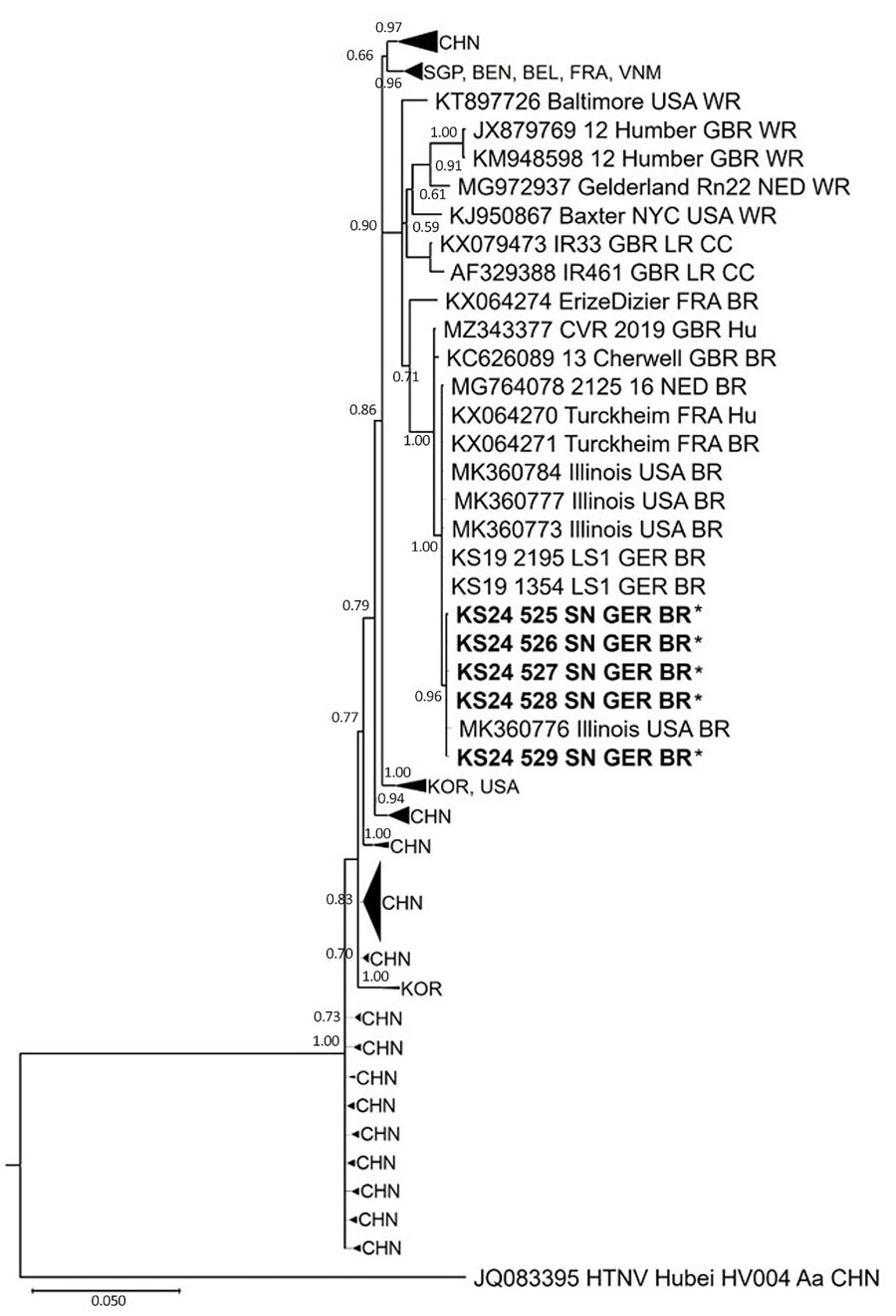Volume 31, Number 10—October 2025
Dispatch
Seoul Virus Infection Acquired at Private Pet Rat Breeding Facility, Germany, 2024
Figure 2

Figure 2. Phylogenetic reconstruction of a partial small segment (731 nt) of Seoul virus isolates (obtained in Saxony state, Germany) in 2024 from rat breeder’s rats implicated in case of severe Seoul virus infection with acute kidney injury, Germany, March 2024. Phylogeny indicates high phylogenetic relatedness among the isolates from the breeder’s rats (bold and asterisks) and other publicly available Seoul virus outbreak strains (4,8) (Appendix). Scale bar indicates the number of substitutions per site. BEL, Belgium; BEN, Benin; BR, breeder rat; CC, cell culture isolate; CHN, China; FRA, France; GBR, Great Britain; GER, Germany; HU, human; KOR, Korea; NED, the Netherlands; SGP, Singapore; USA, United States; VNM, Vietnam; WR, wild rat.
References
- Jonsson CB, Figueiredo LTM, Vapalahti O. A global perspective on hantavirus ecology, epidemiology, and disease. Clin Microbiol Rev. 2010;23:412–41. DOIPubMedGoogle Scholar
- Kruger DH, Figueiredo LTM, Song J-W, Klempa B. Hantaviruses—globally emerging pathogens. J Clin Virol. 2015;64:128–36. DOIPubMedGoogle Scholar
- Cuperus T, de Vries A, Hoornweg TE, Fonville M, Jaarsma RI, Opsteegh M, et al. Seoul virus in pet and feeder rats in the Netherlands. Viruses. 2021;13:443. DOIPubMedGoogle Scholar
- Hofmann J, Ulrich RG, Mehl C, Drewes S, Esser J, Loyen M, et al. Hantavirus disease cluster caused by Seoul virus, Germany. Emerg Infect Dis. 2024;30:133–5. DOIPubMedGoogle Scholar
- Clement J, LeDuc JW, Lloyd G, Reynes J-M, McElhinney L, Van Ranst M, et al. Wild rats, laboratory rats, pet rats: global Seoul hantavirus disease revisited. Viruses. 2019;11:652. DOIPubMedGoogle Scholar
- Hofmann J, Heuser E, Weiss S, Tenner B, Schoppmeyer K, Esser J, et al. Autochthonous ratborne Seoul virus infection in woman with acute kidney injury. Emerg Infect Dis. 2020;26:3096–9. DOIPubMedGoogle Scholar
- Johansson P, Yap G, Low H-T, Siew C-C, Kek R, Ng L-C, et al. Molecular characterization of two hantavirus strains from different rattus species in Singapore. Virol J. 2010;7:15. DOIPubMedGoogle Scholar
- Heuser E, Drewes S, Trimpert J, Kunec D, Mehl C, de Cock MP, et al. Pet rats as the likely reservoir for human Seoul orthohantavirus infection. Viruses. 2023;15:467. DOIPubMedGoogle Scholar
- Haake AFH, Eisenberg T, Heuser E, Stollberg KC, Richter MH, Dreesman J, et al. Cuddle with care! A current overview of zoonotic pathogens transmitted by pet rats. Berl Munch Tierarztl Wochenschr. 2024;137:1–17. DOIGoogle Scholar
1These first authors contributed equally to this article.